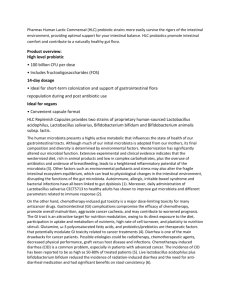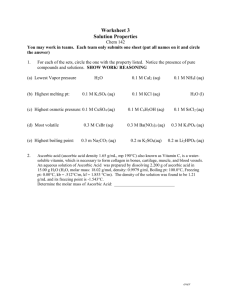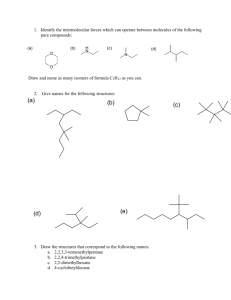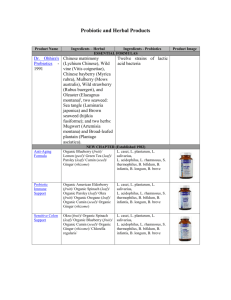Advance Journal of Food Science and Technology 5(6): 678-681, 2013
advertisement
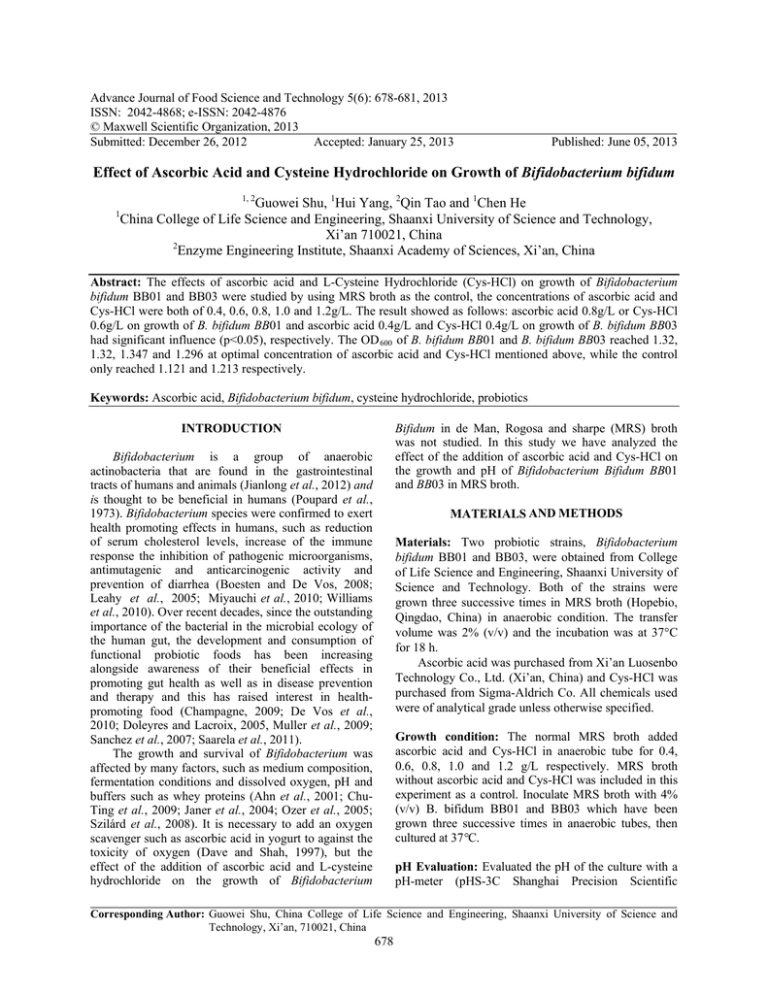
Advance Journal of Food Science and Technology 5(6): 678-681, 2013 ISSN: 2042-4868; e-ISSN: 2042-4876 © Maxwell Scientific Organization, 2013 Submitted: December 26, 2012 Accepted: January 25, 2013 Published: June 05, 2013 Effect of Ascorbic Acid and Cysteine Hydrochloride on Growth of Bifidobacterium bifidum 1, 2 Guowei Shu, 1Hui Yang, 2Qin Tao and 1Chen He China College of Life Science and Engineering, Shaanxi University of Science and Technology, Xi’an 710021, China 2 Enzyme Engineering Institute, Shaanxi Academy of Sciences, Xi’an, China 1 Abstract: The effects of ascorbic acid and L-Cysteine Hydrochloride (Cys-HCl) on growth of Bifidobacterium bifidum BB01 and BB03 were studied by using MRS broth as the control, the concentrations of ascorbic acid and Cys-HCl were both of 0.4, 0.6, 0.8, 1.0 and 1.2g/L. The result showed as follows: ascorbic acid 0.8g/L or Cys-HCl 0.6g/L on growth of B. bifidum BB01 and ascorbic acid 0.4g/L and Cys-HCl 0.4g/L on growth of B. bifidum BB03 had significant influence (p<0.05), respectively. The OD 600 of B. bifidum BB01 and B. bifidum BB03 reached 1.32, 1.32, 1.347 and 1.296 at optimal concentration of ascorbic acid and Cys-HCl mentioned above, while the control only reached 1.121 and 1.213 respectively. Keywords: Ascorbic acid, Bifidobacterium bifidum, cysteine hydrochloride, probiotics Bifidum in de Man, Rogosa and sharpe (MRS) broth was not studied. In this study we have analyzed the effect of the addition of ascorbic acid and Cys-HCl on the growth and pH of Bifidobacterium Bifidum BB01 and BB03 in MRS broth. INTRODUCTION Bifidobacterium is a group of anaerobic actinobacteria that are found in the gastrointestinal tracts of humans and animals (Jianlong et al., 2012) and is thought to be beneficial in humans (Poupard et al., 1973). Bifidobacterium species were confirmed to exert health promoting effects in humans, such as reduction of serum cholesterol levels, increase of the immune response the inhibition of pathogenic microorganisms, antimutagenic and anticarcinogenic activity and prevention of diarrhea (Boesten and De Vos, 2008; Leahy et al., 2005; Miyauchi et al., 2010; Williams et al., 2010). Over recent decades, since the outstanding importance of the bacterial in the microbial ecology of the human gut, the development and consumption of functional probiotic foods has been increasing alongside awareness of their beneficial effects in promoting gut health as well as in disease prevention and therapy and this has raised interest in healthpromoting food (Champagne, 2009; De Vos et al., 2010; Doleyres and Lacroix, 2005, Muller et al., 2009; Sanchez et al., 2007; Saarela et al., 2011). The growth and survival of Bifidobacterium was affected by many factors, such as medium composition, fermentation conditions and dissolved oxygen, pH and buffers such as whey proteins (Ahn et al., 2001; ChuTing et al., 2009; Janer et al., 2004; Ozer et al., 2005; Szilárd et al., 2008). It is necessary to add an oxygen scavenger such as ascorbic acid in yogurt to against the toxicity of oxygen (Dave and Shah, 1997), but the effect of the addition of ascorbic acid and L-cysteine hydrochloride on the growth of Bifidobacterium MATERIALS AND METHODS Materials: Two probiotic strains, Bifidobacterium bifidum BB01 and BB03, were obtained from College of Life Science and Engineering, Shaanxi University of Science and Technology. Both of the strains were grown three successive times in MRS broth (Hopebio, Qingdao, China) in anaerobic condition. The transfer volume was 2% (v/v) and the incubation was at 37°C for 18 h. Ascorbic acid was purchased from Xi’an Luosenbo Technology Co., Ltd. (Xi’an, China) and Cys-HCl was purchased from Sigma-Aldrich Co. All chemicals used were of analytical grade unless otherwise specified. Growth condition: The normal MRS broth added ascorbic acid and Cys-HCl in anaerobic tube for 0.4, 0.6, 0.8, 1.0 and 1.2 g/L respectively. MRS broth without ascorbic acid and Cys-HCl was included in this experiment as a control. Inoculate MRS broth with 4% (v/v) B. bifidum BB01 and BB03 which have been grown three successive times in anaerobic tubes, then cultured at 37°C. pH Evaluation: Evaluated the pH of the culture with a pH-meter (pHS-3C Shanghai Precision Scientific Corresponding Author: Guowei Shu, China College of Life Science and Engineering, Shaanxi University of Science and Technology, Xi’an, 710021, China 678 Adv. J. Food Sci. Technol., 5(6): 678-681, 2013 6.0 1.2 Instrument Co., Ltd, Shanghai, China) and repeated at regular intervals. 5.8 1.0 5.6 OD OD(BB01) OD(BB03) pH(BB01) pH(BB03) 0.6 0.4 5.4 5.2 pH 0.8 Growth determination: Monitored the growth of the strains by measuring the optical density of the culture at 600 nm (OD 600 ) through a spectrophotometer (SP756PC, Shanghai Spectrum Instruments Co., Ltd., Shanghai, China). 5.0 4.8 0.2 4.6 0.0 4.4 0 Statistical analysis: The difference between the two average values was calculate by t-test of SigmaPlot 11.0 and if (p<0.05), it indicative of a significant difference between the average values. 5 10 15 Time((h) 20 25 Fig. 1: Growth curve of B.Bifidum in MRS broth 1.4 RESULTS AND DISCUSSION 1.2 1.0 OD Growth of Bifidobacterium bifidum BB01 and BB03 in MRS broth: The growth of control group in MRS broth was showed in Fig. 1. The lag phase of the two strains was 0-2 h which OD 600 and pH almost unchanged. Then OD 600 increased rapidly and pH dropped sharply showing that the strains grown to exponential phase. After 24 h, OD 600 increased slowly and came into stationary phase. 0.8 0.4g/l 0.6g/l 0.8g/l 1.0g/l 1.2g/l 0.6 0.4 0.2 0.0 0 4 8 12 16 Time(h) 20 24 Fig. 2: Effect of ascorbic acid on growth of B.bifidum BB01 Effect of ascorbic acid on growth of Bifidobacterium bifidum: The effect of different concentrations of ascorbic acid on the growth of B. bifidum BB01 and BB03 showed in Fig. 2-5. With the increasing concentration of ascorbic acid, OD 600 of BB01 increased gradually and then decreased and the maximum at different incubation time were corresponding to different concentration. The maximum OD 600 and relevant concentration of ascorbic acid in each measured time was 1.067 at 0.6 g/L (10 h), 1.320 at 0.8 g/L (18 h) and 1.294 at 0.6 g/L (24 h), respectively. The pH of culture medium was in contrast with the OD 600 of the strain, which indicated that ascorbic acid played a significant role in promoting the growth of B.bifidum BB01. The optimum concentration of ascorbic acid in MRS broth of B.bifidum BB01 was 0.8 g/L cultured for 18h (p<0.05). However, OD 600 of B.bifidum BB03 was decreased with the increase of ascorbic acid concentration. The OD 600 in each measured time reached maximum at 0.4 g/L ascorbic acid which respectively 1.10 (10 h), 1.314 (18 h) and 1.347 (24 h) while the control was 0.912 (10 h), 1.147 (18 h) and 1.213 (24 h). The pH of culture medium was also in contrast with the OD 600 of the strain and the optimum concentration of ascorbic acid in MRS broth of B.bifidum BB03 was 0.4 g/L cultured for 24 h (p<0.05). 5.7 0.4g/l 0.6g/l 0.8g/l 1.0g/l 1.2g/l pH 5.4 5.1 4.8 4.5 4.2 0 4 8 12 16 20 24 Time(h) Fig. 3: Effect of ascorbic acid on pH of B.bifidum BB01 1.4 1.2 OD 1.0 0.4g/l 0.6g/l 0.8g/l 1.0g/l 1.2g/l 0.8 0.6 0.4 0.2 0.0 0 4 8 12 16 20 24 Time (h) Fig. 4: Effect of ascorbic acid on growth of B.bifidum BB03 HCl on the growth of B.bifidum BB01 and BB03 showed in Fig. 6-9. With the increasing concentration of Cys-HCl, OD 600 of BB01 increased gradually and then decreased and the maximum at different Effect of Cys-HCl on growth of Bifidobacterium bifidum: The effect of different concentrations of Cys679 Adv. J. Food Sci. Technol., 5(6): 678-681, 2013 1.4 5.8 1.2 5.6 0.4g/l 0.6g/l 0.8g/l 1.0g/l 1.2g/l pH 5.2 5.0 4.8 1.0 pH 5.4 0.2 0.0 4.4 0 4.2 0 4 8 12 16 20 1.2 1.0 0.4g/l 0.6g/l 0.8g/l 1.0g/l 1.2g/l 0.4 0.2 0.0 0 4 8 12 16 20 24 Time(h) Fig. 6: Effect of Cys-HCl on growth of B.bifidum BB01 6.0 5.8 5.6 5.4 5.2 5.0 4.8 4.6 4.4 4.2 12 16 Time (h) 20 24 1.320 at 0.6 g/L (24 h), respectively; however the maximum OD 600 of the control group was 1.121 at 24 h. The pH of culture medium was in contrast with the OD 600 of the strain, which indicated that Cys-HCl played a significant role in promoting the growth of B.bifidum BB01. The optimum concentration of CysHCl in MRS broth of B.bifidum BB01 was 0.6g/L cultured for 24h (p<0.05). Similarly, OD 600 of BB03 increased rapidly and then decreased with the increase of Cys-HCl concentration. The maximum OD 600 and relevant concentration of Cys-HCl in each measured time was 1.026 at 0.6 g/L (10 h), 1.296 (18 h) and 1.257 (24 h) at 0.4 g/L, respectively. And the OD 600 of the control at 18 h and 24 h was 1.147 and 1.213 which was also indicative that cultured more than 18h has negative effect on growth of B.bifidum BB03. The pH of culture medium was in contrast with the OD 600 of the strain and the optimum concentration of Cys-HCl in MRS broth of B.bifidum BB03 was 0.4g/L cultured for 18h (p<0.05). 1.4 0.6 8 Fig. 9: Effect of Cys-HCl on pH of B.bifidum BB03 Fig. 5: Effect of ascorbic acid on pH of B.bifidum BB03 0.8 4 24 Time(h) OD 0.4g/l 0.6g/l 0.8g/l 1.0g/l 1.2g/l 0.6 0.4 4.6 pH 0.8 0.4g/l 0.6g/l 0.8g/l 1.0g/l 1.2g/l CONCLUSION 0 4 8 12 16 20 24 Addition of ascorbic acid and Cys-HCl both have the significant promotion on growth of B. bifidum BB01 and BB03. Adding 0.8 g/L ascorbic acid or 0.6 g/L CysHCl on growth of B. bifidum BB01 and 0.4 g/L ascorbic acid or 0.4 g/L Cys-HCl on growth of B. bifidum BB03 have significant influence (p<0.05), respectively. Time (h) Fig. 7: Effect of Cys-HCl on pH of B.bifidum BB01 1.4 1.2 OD 1.0 ACKNOWLEDGMENT 0.8 0.4g/l 0.6g/l 0.8g/l 1.0g/l 1.2g/l 0.6 0.4 0.2 The authors wish to thank the helpful comments and suggestions from my colleagues in probiotics lab of China College of Life Science and Engineering, Shaanxi University of Science and Technology at Xi’an. The study was supported by the key project of Shaanxi Academy of Sciences (No: 2010K-03). 0.0 0 4 8 12 16 Time (h) 20 24 REFERENCES Fig. 8: Effect of Cys-HCl on growth of B.bifidum BB03 Ahn, J.B., H.J. Hwang and J.H. Park, 2001. Physiological responses of oxygen-tolerant anaerobic Bifidobacterium longum under oxygen. J. Microbiol. Biotechnol., 11(3): 443-451. incubation time were corresponding to different concentration. The maximum OD600 and relevant concentration of Cys-HCl in each measured time was 0.998 at 0.6 g/L (10 h), 1.149 at 0.8 g/L (18 h) and 680 Adv. J. Food Sci. Technol., 5(6): 678-681, 2013 Boesten, R.J. and W.M. De Vos, 2008. Interactomics in the human intestine: Lactobacilli and bifidobacteria make a difference. J. Clin. Gastroenterol., 42: 163-167. Champagne, C.P., 2009. Some Technological Challenges: In the Addition of Probiotic Bacteria to Foods. In: Charalampopoulus, D. and R.A. Rastall, (Eds.), Prebiotics and Probiotics Science and Technology. Springer, Berlin, pp: 761-804. Chu-Ting, L., H. Ting and C. Cheng-Chun, 2009. Exopolysaccharide production of Lactobacillus salivarius BCRC 14759 and Bifidobacterium bifidum BCRC 14615. World J. Microbiol. Biotechnol., 25: 883-890. Dave, R.I. and N.P. Shah, 1997. Effectiveness of ascorbic acid as an oxygen scavenger in improving viability of probiotic bacteria in yoghurts made with commercial starter cultures. Int. Dairy J., 7: 435-443. De Vos, P., M.M. Faas, M. Spasojevic and J. Sikkema, 2010. Encapsulation for preservation of functionality and targeted delivery of bioactive food components. Int. Dairy J., 20: 292-302. Doleyres, Y. and C. Lacroix, 2005. Technologies with free and immobilised cells for probiotic bifidobacteria: Production and protection. Int. Dairy J., 15: 973-988. Janer, C., C. Pelaez and T. Requena, 2004. Caseinomacropeptide and whey protein concentrate enhance bifidobacterium lactis growth in milk. Food Chem., 86(2): 263-267. Jianlong, H., S. Kouta and S. Tohru, 2012. Determination of the ribosome-binding sequence and spacer length between binding site and initiation codon for efficient protein expression in Bifidobacterium longum 105-A. J. Biosci. Bioeng., 113(4): 442-444. Leahy, S.C., D.G. Higgins, G.F. Fitzgerald and D.V. Sinderen, 2005. Getting better with bifidobacteria. J. Appl. Microbiol., 98: 1303-1315. Miyauchi, E., J.Z. Xiao and S. Tanabe, 2010. Interaction of Bifidobacteria with the Intestinal Mucosa: With a Focus on Immunomodulating Effects. Caister Academic Press. Muller, J.A., R.P. Ross, G.F. Fitzgerald and C. Stanton, 2009. Manufacture of Probiotic Bacteria. In: Charalampopoulos, D. and R.A. Rastall (Eds.), Prebiotics and Probiotics Science and Technology. Springer, Berlin, pp: 725-759. Ozer, D., S. Akin and B. Ozer, 2005. Effect of inulin and lactulose on survival of lactobacillus acidophilus LA-5 and Bifidobacterium bifidum BB-02 in acidophilus bifidus Yoghurt. Food Sci. Technol. Int., 11(1): 19-24. Poupard, J.A., I. Husain and R.F. Norris, 1973. Biology of the bifidobacteria. Bacteriol. Rev., 37: 136-165. Saarela, M.H., H.L. Alakomi, J. Mättö, A.M. Ahonen and S. Tynkkynen, 2011. Acid tolerant mutants of Bifidobacterium animalis subsp. lactis with improved stability in fruit juices. LWT - Food Sci. Technol., 44: 1012-1018. Sanchez, B., M.C. Champomier-Verges, M.D. Collado, P. Anglade, F. Baraige and Y. Sanz, 2007. Low-pH adaptation and the acid tolerance response of Bifidobacterium longum biotype longum. Appl. Env. Microbiol., 73: 6450-6459. Szilárd, K., J.M. Rezessy-Szabó and Q.D. Nguyen, 2008. Changes of microbial population and some components in carrot juice during fermentation with selected Bifidobacterium strains. Proc. Biochem., 43(8): 816-821. Williams, M.D., C.Y. Ha and M.A. Ciorba, 2010. Probiotics as therapy in gastroenterology: A study of physician opinions and recommendations. J. Clinical Gastroenterol., 44: 631-636. 681
